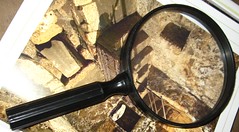This technique is similar to using framing for burying clues, but distinct enough I think it warrants its own entry in the series.
In this method, the clue really is in plain sight. No tricks to cover it up or conceal its importance—only its meaning. Using the viewpoint character’s perspective, we explain away the clue because we’re seeing it out of context. Perhaps the POV character isn’t hunting for clues right now, or maybe we’ve moved from the plot with the mystery into a subplot involving other characters—anything to move the POV character’s frame of mind somewhere else so that the clue doesn’t seem to bear any extra significance.
To cite an example I gave in the comments of an Edittorrent discussion on burying clues (although this is a mystery, the concept applies across genres; emphasis added):
Let’s say that your plot is structured so that the hero is a detective and there’s been a murder at our heroine’s office (her supervisor was killed [with a staple gun, which our heroine doesn’t know], and there’s an obvious suspect). In her free time, our heroine has been helping her best friend start her own cafe.
Our heroine is helping to decorate the cafe (in her subplot). Her BFF asks her to hang the grapevine lattice on the ceiling, since she’s afraid of heights. The heroine takes the lattice and the staple gun up the ladder and obliges.
But really, the BFF is avoiding the staple gun because she killed the coworker (insert motive here). But because we’re out of context, given a plausible alternate explanation, and not in an investigative POV (and note the BFF doesn’t mention the weapon of choice), it’s easy to dismiss it (as long as there’s a clear purpose in the scene, too).
Plus, now the BFF can frame our heroine with her prints on the murder weapon.
Jami Gold also gave a great example of a slightly different methodology for doing this in the comments. The POV character interprets the clues into a context that might make sense to them, but it’s not correct. The heroine thinks the hero’s giving her A Look because he doesn’t approve of the friends she’s going out with (or doesn’t care about her); the hero can’t believe she’s ditching him.
What do you think? How do you use context and interpretation to bury clues?
Photo by Scott Vandehey




